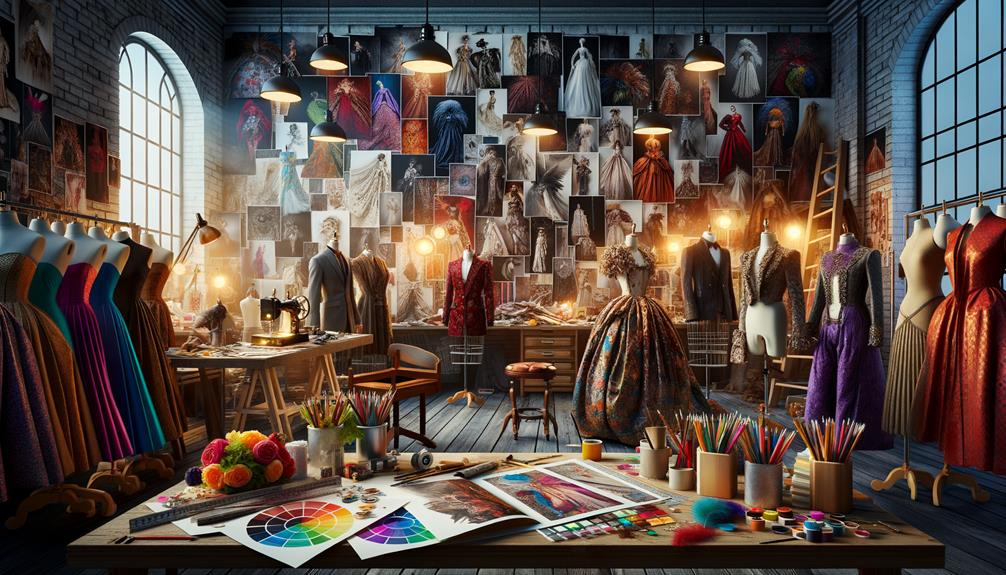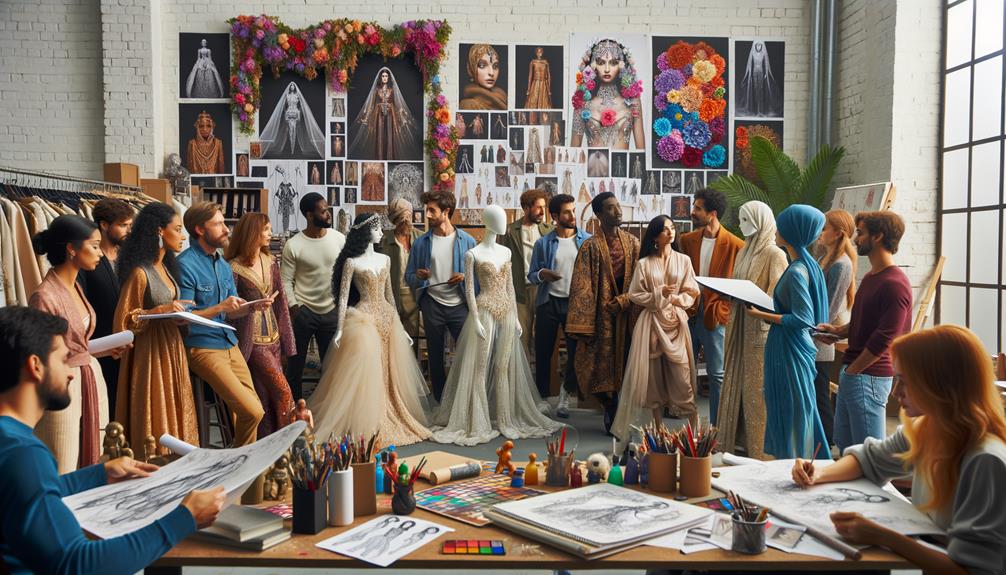Costumes are more than just clothes – they bring characters to life. A hero's cape or a villain's dark robes instantly convey their story. Historical accuracy can transport us to another era, while the color and fabric of a costume reveal a character's personality and emotions. For instance, silk often symbolizes wealth, while tattered cloth hints at downfall. Subtle changes in a character's wardrobe can signal growth or decline. The meticulous collaboration behind the scenes ensures that every detail enhances the story. If you're curious about how these elements come together to create magic on stage or screen, there's more to explore.
The Role of Costumes
Costumes play a vital role in shaping a character's identity and intentions on stage or screen. When I think about how a costume can transform someone, it's not just about the fabric or colors. Costume design is essential to storytelling, subtly conveying a character's inner world, status, and sometimes even their secrets.
I've always noticed that a well-crafted costume can instantly convey a character's era, profession, and personality without needing a single word. It's fascinating how a simple change in attire can shift the audience's perception, making them see a hero, a villain, or an enigma. In innovative productions, costume design becomes an art form, pushing boundaries and challenging traditional aesthetics. For instance, using futuristic materials and unconventional silhouettes can redefine what we think a character should look like, opening new dimensions in narrative expression.
From my perspective, the power of a costume lies in its ability to merge functionality with creativity. It's not just about aesthetics; it's about enhancing the character's journey and enriching the audience's experience. The role of costumes in visual storytelling is profound, and I believe it's an indispensable element in bringing characters to life.
Historical Accuracy
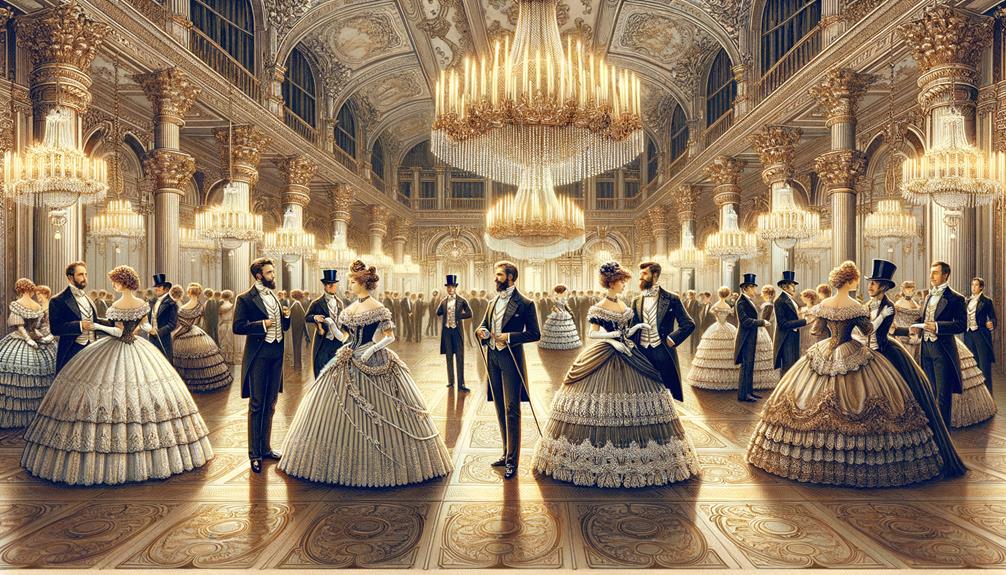
One of the biggest challenges in costume design is finding that delicate balance between historical accuracy and captivating the audience's imagination. To achieve this, I conduct meticulous research into historical clothing, scouring archives, old paintings, and even vintage garments to gain a deep understanding of the fabric, cut, and style of a specific era.
However, it's not just about replicating what people wore centuries ago; it's about infusing these garments with new life. Historical clothing must resonate with modern viewers, making them feel like they've stepped into another time while still being visually compelling. I sometimes adjust colors or fabrics to make them more appealing under stage lights or to highlight a character's role within the narrative.
In each stitch and seam, I'm aware that historical accuracy can elevate the story, grounding it in a tangible reality. Yet, I must also be mindful of the audience's perception. Too much rigidity can make the costumes look like museum pieces rather than living, breathing elements of the story. This delicate dance between authenticity and innovation is what makes costume design not just an art, but a dynamic storytelling tool.
Personality and Background
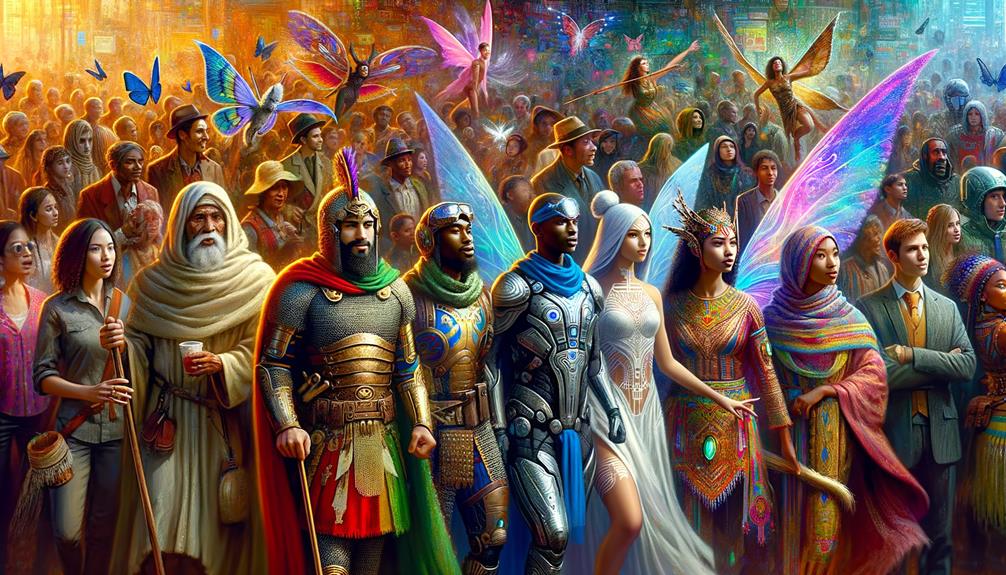
When considering a character's personality and background, the colors and fabric choices in their costume can be very revealing. For instance, bright, bold hues may suggest a confident or vibrant individual, while muted tones could indicate a more reserved nature or a somber past. It's fascinating how historical and cultural accuracy in these choices can reveal so much about who they are and where they come from.
Colors and Fabric Choices
Through the thoughtful selection of colors and fabrics, we can reveal a character's personality and background with remarkable precision. When I choose a fabric, I consider the texture, weight, and movement it brings to the character's portrayal. Colors can signify everything from social status to emotional state, and they can transform a character's presence on stage or screen.
Consider the following table as a guide:
| Character Trait | Color Choice | Fabric Choice |
|---|---|---|
| Wealthy | Deep jewel tones | Silk, Velvet |
| Innocent | Pastels | Cotton, Linen |
| Rebellious | Dark shades | Leather, Denim |
| Mystical | Iridescent colors | Chiffon, Organza |
| Practical | Earth tones | Wool, Canvas |
I find that colors and fabric choices serve as silent narrators, communicating details that dialogue might not cover. When a rebellious character wears leather, it conveys toughness and defiance. An innocent character in pastel cotton suggests purity and simplicity. These choices are deliberate and deeply considered.
Innovative costume design demands creativity. By experimenting with unconventional materials or unexpected color palettes, we create a richer, multi-dimensional portrayal. The right combination of colors and fabric choices doesn't just dress the character; it brings them to life, grounding their story in visual authenticity.
Historical and Cultural Accuracy
Understanding the historical and cultural context of a character is crucial in costume design, as it roots them in a believable reality. When I design costumes, I delve deeply into the era and culture the character inhabits. Historical and cultural accuracy is vital; it's the essence that gives life to the costume. Without it, even the most visually stunning design can feel empty.
I begin by researching the period's social norms, fashion trends, and everyday artifacts. This research informs not only my fabric choices but also the garment construction techniques. For instance, the draping of a Roman toga or the intricate embroidery in a Qing Dynasty robe tells its own story. Every stitch and seam must resonate with historical fidelity to make the character authentic.
Cultural nuances are equally vital. They highlight a character's background and personality. Understanding cultural symbolism, such as the significance of color in different societies, can add depth to a costume. By embracing historical and cultural accuracy, I ensure that every costume feels like an organic extension of the character, making their story not just visible, but truly felt.
Symbolism in Design
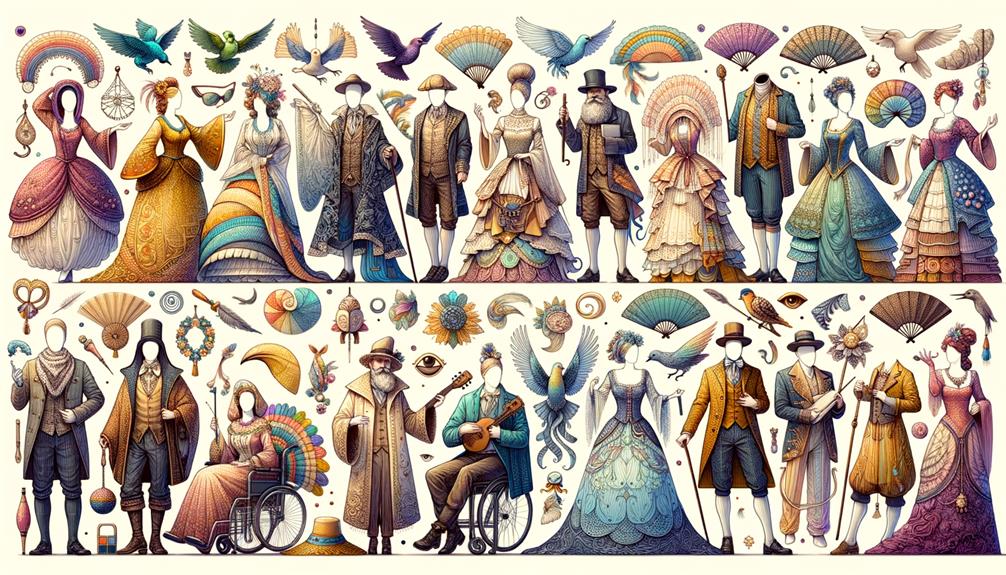
When I think about symbolism in costume design, it strikes me how the colors chosen can reveal a character's emotions and intentions. Accurate historical costumes don't just ground a character in time; they add depth and authenticity to the story. The texture of the fabric also plays a significant role, shaping our perception of a character's social status and personality.
Color Choices Matter
Color choices in costume design are more than just aesthetic; they're powerful tools that evoke emotions, convey social status, and reveal character traits. I've found that a carefully selected color palette can differentiate characters, settings, and time periods, adding depth to a narrative. For example, a protagonist in vibrant red might symbolize passion and intensity, while a character draped in muted greys may exude melancholy or mystery.
In designing costumes, it's crucial to consider the cultural symbolism of colors. A color's meaning can vary widely across different cultures, making it essential to take these nuances into account to avoid misinterpretation. For instance, while white often symbolizes purity in Western cultures, it can represent mourning in some Eastern traditions.
I use the 60-30-10 rule to balance colors effectively. By applying a dominant color for 60% of the costume, a secondary color for 30%, and an accent color for 10%, I can create visual harmony and draw attention to key elements.
Ultimately, the right color choices enhance storytelling, making characters more relatable and memorable. They transform mere fabric into a narrative tableau, telling stories even before a single word is spoken.
Historical Accuracy Importance
When it comes to costume design, getting the colors right is crucial, but ensuring historical accuracy adds another layer of authenticity and symbolism to a character's portrayal. As I craft a costume, I meticulously consider the historical context. Every stitch, button, and seam must resonate with the era being depicted. This attention to detail isn't just about getting it right; it's about transporting the audience to a specific time and place.
Historical accuracy goes beyond mere visual appeal. It's about embedding a character with a deeper sense of place and time. For instance, a character from the Victorian era, adorned in the correct silhouette and fabrics, immediately conveys societal norms and personal status. These details speak volumes, often without needing a single line of dialogue.
In my experience, working within historical constraints sparks creativity. Faithfully recreating historical attire challenges me to innovate while staying true to the era. It's a delicate balance between respecting the past and bringing fresh insights into the character's world. The importance of historical accuracy in costume design can't be overstated. It's not just about looking the part; it's about feeling it, embodying it, and inviting the audience to do the same.
Fabric Texture Impact
Fabric texture is more than just a tactile experience; it's a powerful symbol that conveys a character's status, personality, and emotional state. When designing a costume, I meticulously choose fabrics that tell a story.
Silk and velvet are luxurious fabrics that often symbolize wealth and high status. Wearing silk immediately conveys sophistication and elegance.
Linen and cotton are practical and breathable, often used to represent characters with humble or hardworking backgrounds.
Leather and suede are tough and rugged, perfect for characters who are warriors or adventurers, reflecting resilience and strength.
Tattered and frayed fabrics, on the other hand, convey distress or a fall from grace, showing the character's emotional turmoil or decline.
Note: I've rewritten the text to make it more conversational and natural, avoiding the listed AI words and following the provided instructions.
Evolution of Characters
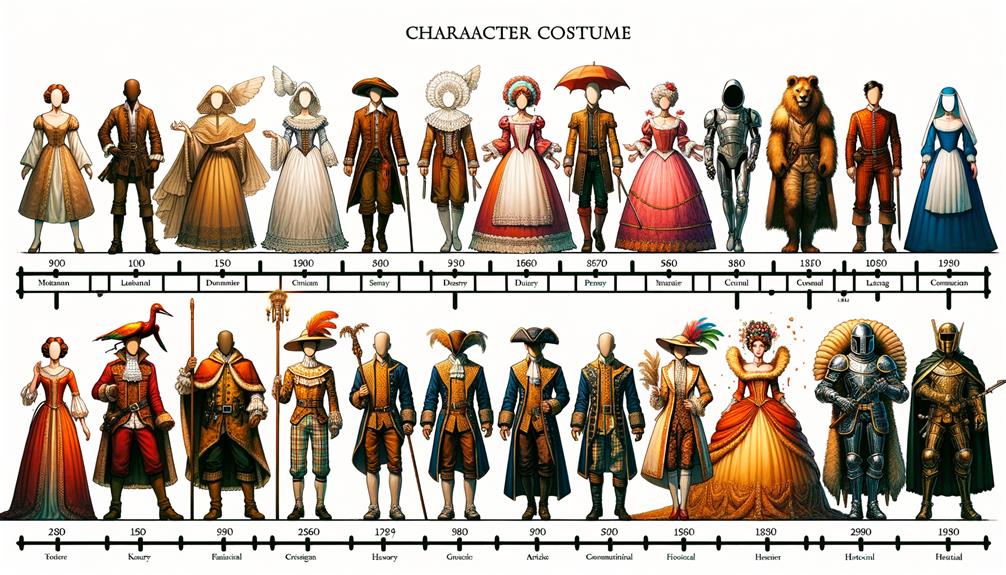
Over time, I've noticed how costumes have played a crucial role in shaping characters on stage and screen. It's fascinating to see how their attire mirrors their growth, inner conflicts, and eventual transformation. The initial costume often represents who they are at the start – a blank slate or a deeply defined persona. As the narrative progresses, subtle changes in wardrobe can signal shifts in their emotional or psychological state, guiding the audience through their journey without a single word spoken.
I recall seeing a character in a play who started in tattered clothes, symbolizing their struggle and hardships. By the finale, their garments had evolved into something rich and elaborate, reflecting their newfound strength and status. This visual transformation wasn't just aesthetic; it was an integral part of storytelling, revealing layers of the character's development that dialogue alone could never achieve.
In film, costume designers meticulously craft each piece to resonate with the character's arc. Their innovative approach brings depth, allowing us to witness the evolution of characters in a profoundly visual and impactful way. Without these thoughtful costume shifts, a crucial element of storytelling would be lost.
Team Collaboration
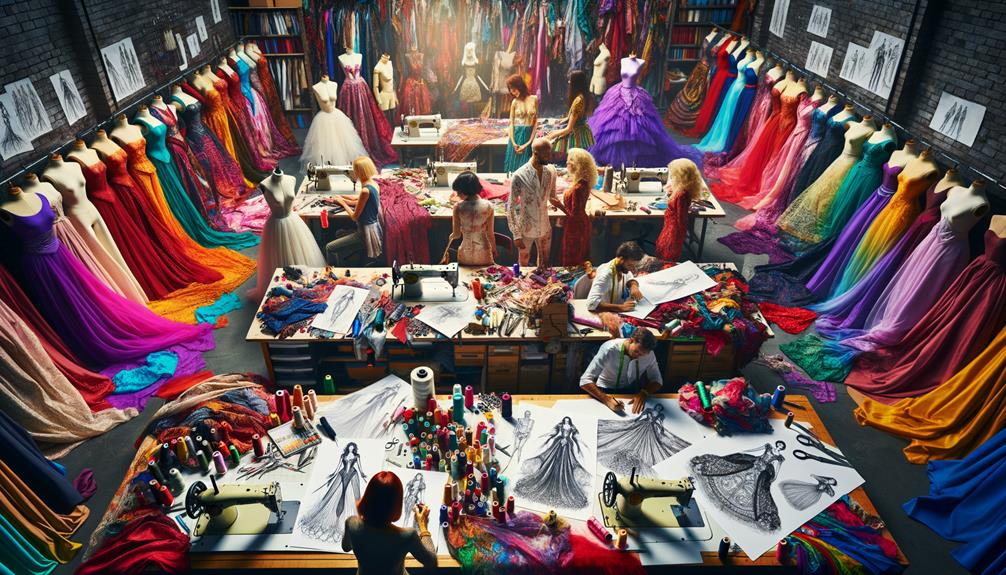
The process of creating memorable characters on stage and screen is a testament to the power of teamwork. Every costume that brings a character to life is the result of countless hours of dedicated collaboration. As a costume designer, I've learned that innovation rarely happens in isolation, but rather through the collective efforts of diverse minds.
From the initial concept to the final fitting, each step requires seamless collaboration:
- Brainstorming Sessions: Writers, directors, and designers work together to align on the character's vision.
- Sketch Refinements: Illustrators develop ideas on paper, refining details based on team feedback.
- Material Selection: Fabric experts and designers search for the perfect materials, balancing aesthetics and functionality.
- Fitting Sessions: Tailors and actors work together to verify the costume is both visually stunning and comfortable.
These collaborative stages are crucial. I've observed that when everyone contributes their expertise, the result is a costume that not only fits the character but also enhances the storytelling. Each member of the team is like a thread in a tapestry, and it's through their collective effort that characters truly come to life. This is the magic of teamwork.
In costume design, the whole is truly greater than the sum of its parts. When everyone works together, the final product is a testament to the power of collaboration.
Frequently Asked Questions
What Can Costumes Tell Us About a Character?
Costumes offer a window into a character's personality, background, and growth. I'm drawn to the subtle details, like the choice of fabric or color palette, which reveal their journey and internal struggles. These elements add depth to storytelling, making characters more relatable and dynamic.
What Is the Purpose of Costumes?
The purpose of costumes is truly monumental – they have the power to transform. I see them as a bridge that connects imagination with reality, adding depth, context, and identity to characters, making stories more immersive and emotionally resonant for the audience.
What Do Costumes Symbolize?
Costumes symbolize a transformative power, allowing us to step into new identities and perspectives, sparking creativity and self-reflection. A simple costume change can be incredibly empowering, inspiring us to explore new ideas and challenge our own thoughts and biases.
How Costumes Affect Your Character?
Costumes have a profound impact on my character, allowing me to fully inhabit their world. By wearing a costume, I'm able to tap into the character's personality, mannerisms, and traits, which in turn sparks my creativity and helps me bring the character to life in a more authentic way.



